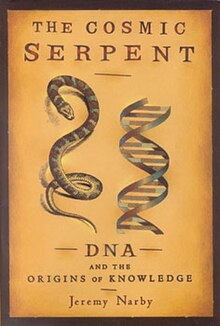| Revision as of 03:36, 15 May 2022 editCT55555 (talk | contribs)Autopatrolled, Extended confirmed users, Page movers, Pending changes reviewers, Rollbackers38,771 edits added Category:Works about ayahuasca using HotCat← Previous edit | Revision as of 11:27, 15 May 2022 edit undoජපස (talk | contribs)Extended confirmed users, Pending changes reviewers, Rollbackers60,473 edits →Synopsis: Jay Griffiths is NOT a reliable source. It would be rather like having a member of the college of cardinals review the pope's book.Tags: Reverted Visual editNext edit → | ||
| Line 32: | Line 32: | ||
| ==Synopsis== | ==Synopsis== | ||
| His own ] ingestion was followed by hallucination and visions of two snakes, which he associates with DNA.<ref name=":0">{{Cite web |last=Griffiths |first=Jay |date=1999-07-07 |title=Serpent's tale |url=http://www.theguardian.com/society/1999/jul/07/guardiansocietysupplement4 |access-date=2022-05-15 |website=] |language=en}}</ref> The book documents numerous indigenous peoples who incorporate images of snakes in their documentation of human creation stories, specifically peoples in the Amazonia, Mexico, Australia, Persia, ], Egypt, India, the Pacific, Greece, Crete, and Scandinavia.<ref name=":0" /> | |||
| Narby documents his years of research, including his own ingestion of ayahuasca, and hypothesizes that shamans may be able to access information at the molecular level through the ingestion of ] and other ].<ref name="iin" /> | |||
| His own ] ingestion was followed by hallucination and visions of two snakes, which he associates with DNA.<ref name=":0" /> The book documents numerous indigenous peoples who incorporate images of snakes in their documentation of human creation stories, specifically peoples in the Amazonia, Mexico, Australia, Persia, ], Egypt, India, the Pacific, Greece, Crete, and Scandinavia.<ref name=":0" /> | |||
| ] ] criticized Narby for not testing his hypothesis.<ref name="iin">{{cite book | |||
| | last =Narby | |||
| | first =Jeremy | |||
| | author-link =Jeremy Narby | |||
| | title =Intelligence in Nature | |||
| | publisher =Penguin | |||
| | year =2006 | |||
| | pages = | |||
| | isbn =1-58542-399-8 | |||
| | url =https://archive.org/details/intelligenceinna0000narb/page/1 | |||
| }}</ref> | |||
| ==Documentary== | ==Documentary== | ||
Revision as of 11:27, 15 May 2022
Book by Jeremy Narby| An editor has nominated this article for deletion. You are welcome to participate in the deletion discussion, which will decide whether or not to retain it.Feel free to improve the article, but do not remove this notice before the discussion is closed. For more information, see the guide to deletion. Find sources: "The Cosmic Serpent" – news · newspapers · books · scholar · JSTOR%5B%5BWikipedia%3AArticles+for+deletion%2FThe+Cosmic+Serpent%5D%5DAFD |
 Penguin paperback cover, showing symbolic correspondence between an image of a snake and DNA Penguin paperback cover, showing symbolic correspondence between an image of a snake and DNA | |
| Author | Jeremy Narby |
|---|---|
| Original title | Le serpent cosmique, l'ADN et les origines du savoir |
| Language | French |
| Publisher | Georg |
| Publication date | 1998 |
| Published in English | 1998 |
| Media type | |
| Pages | 257 |
| ISBN | 2-8257-0495-4 |
| OCLC | 34122475 |
| Followed by | Intelligence in Nature |
The Cosmic Serpent: DNA and the Origins of Knowledge is a 1998 non-fiction book by anthropologist Jeremy Narby.
The book documents Narby's time researching in the Amazon rainforest and his hypothesis that indigenous peoples throughout the world have understood what modern scientists know of DNA for thousands of years.
Research
Narby performed two years of field work in the Pichis Valley of the Peruvian Amazon researching the ecology of the Asháninka, an indigenous peoples in Peru.
Synopsis
His own ayahuasca ingestion was followed by hallucination and visions of two snakes, which he associates with DNA. The book documents numerous indigenous peoples who incorporate images of snakes in their documentation of human creation stories, specifically peoples in the Amazonia, Mexico, Australia, Persia, Sumer, Egypt, India, the Pacific, Greece, Crete, and Scandinavia.
Documentary
Narby and three molecular biologists revisited the Peruvian Amazon to try to test the hypothesis, and their work is featured in the documentary film, Night of the Liana.
See also
References
- Wishart, Paul M. "Reflections on the cosmic serpent." Spirituality and Health International 3.4 (2002): 50-53.
- ^ Griffiths, Jay (1999-07-07). "Serpent's tale". The Guardian. Retrieved 2022-05-15.
- Grant, John (2006). Discarded Science. Sterling Publishing. pp. 285–286. ISBN 1-904332-49-8.
Further reading
- Posner, Michael. article, "Plants with Soul", . The Walrus, Jul/Aug 2006.
- Shanon, Benny. (2002). Antipodes of the Mind: Charting the Phenomenology of the Ayahuasca Experience. Oxford University Press. ISBN 0-19-925292-0
- Stewart, Todd. "The Cosmic Serpent: An interview with Jeremy Narby" in ascent magazine. Issue 03. 1999.